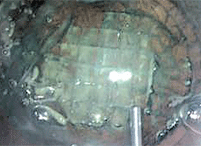 How often have your patients asked if the cataract surgery you’re recommending to them is performed with a laser? This question seems to come up quite often, because many patients believe that lasers are necessary to perform all advanced surgical procedures, especially in the realm of eye care. Although doctors have been emulsifying cataracts with ultrasound for years, the truth is that we are only now exploring the use of laser technology in cataract surgery.
How often have your patients asked if the cataract surgery you’re recommending to them is performed with a laser? This question seems to come up quite often, because many patients believe that lasers are necessary to perform all advanced surgical procedures, especially in the realm of eye care. Although doctors have been emulsifying cataracts with ultrasound for years, the truth is that we are only now exploring the use of laser technology in cataract surgery.
Several recent studies have indicated that femtosecond laser, a technology commonly used in LASIK procedures, holds significant potential for patients with cataracts.1-7 Today, femtosecond lasers are used in cataract surgery to create incisions and exact capsulotomies, as well as to fragment the cataractous nucleus.7
Currently, three companies are investigating the use of femtosecond laser to assist in cataract surgery: LensAR, LenSx and OptiMedica. In fact, LenSx’s femtosecond laser received FDA clearance for anterior capsulotomy in September 2009.
Femtosecond Technology

Lens fragmentation performed by the LensAR femtosecond laser system.
Femtosecond laser energy is on a 10nm to 15nm wavelength that can cut through tissue without significant energy release. First conceived as a procedure for intrastromal ablation, femtosecond laser is widely used to accurately cut a LASIK flap.1,2
In addition to LASIK surgery, this technology can be used to create channels for the implantation of Intacs (Addition Technology) in patients with keratoconus.3 More recently, clinicians have used femtosecond lasers in corneal transplant surgery and/or keratoplasty to more accurately cut the host and donor tissue and evenly create patterns within the graft edges so the transplant can interconnect with enhanced stability, accuracy and precision.4,5 Additionally, femtosecond lasers have been shown to help create thin, precise donor grafts for endothelial transplants or Descemet’s stripping endothelial keratoplasty (DSEK).6
Use in Cataract Surgery
A femtosecond laser can create a preset capsulotomy or an opening in the capsule to initiate a cataract surgery procedure. The lasers can be programmed to an exact diameter to create a perfectly symmetric capsulotomy.7 Most notably, a precise, reproducible capsular opening can enhance IOL alignment and yield improved refractive outcomes.
Several reports indicate that femtosecond lasers are more accurate than current surgical capsulorrhexis procedures because the capsulotomy can be centered precisely on the visual axis to match the intraocular lens diameter. One study compared postoperative outcomes in 60 patients who underwent capsulotomy performed by femtosecond laser and 60 patients who underwent manual capsulorrhexis.7 Upon initial observation, all patients in the femtosecond laser group exhibited perfectly centered capsular openings within 0.25mm of the intended diameter, with no adverse events. By contrast, just 10% of the patients who underwent manual capsulorrhexis procedures had capsular openings within 0.25mm of the intended diameter.7
Future generations of accommodating IOLs will benefit tremendously from the use of femtosecond laser, because the technology allows clinicians to match the capsulotomy to the mid-dilated pupil size and better align the optics of the lens.
Finally, data from newer studies suggest that femtosecond lasers can effectively divide the cataract, eliminating the need for a surgeon to manually cleave or chop its nucleus.7 By this method, femtosecond lasers will simplify some of the more tedious steps in the cataract removal process and increase the surgeon’s clinical efficiency.
Other Applications
In addition to the uses outlined above, femtosecond lasers could have several other ophthalmic applications:
• Astigmatism correction. Femtosecond lasers may be used to make precise limbal relaxing incisions to correct for astigmatism.8,9
• Presbyopia correction. Femtosecond lasers can be used to treat presbyopia without the risk of inducing a cataract from conventional laser ablation.10 Currently, German researchers are using the femtosecond laser to make a specialized incision on the periphery of the lens in patients with reduced visual acuity.11 The researchers are hoping to see an improvement in lens elasticity, which could help restore natural accommodation.12
• Lens bleaching. Femtosecond lasers could be used to bleach age-induced yellowing of the crystalline lens. In one study, patients experienced reduced lenticular yellowing as well as increased light transmission following treatment with an 800nm infrared femtosecond pulsed laser.13 The researchers estimated that the procedure removed an average of three to seven years of age-induced discoloration.13
All-laser cataract surgery is no longer a futuristic procedure. Additionally, other applications of femtosecond laser, such as astigmatism or presbyopia correction and lens bleaching, are possible to help restore accommodation and ensure that your patients live comfortably. In any case, now you know what to tell your patients the next time they ask, “Is cataract surgery performed with a laser?”
Neither Dr. Karpecki nor Dr. Shechtman have any financial interest in the technologies mentioned.
1. Lubatschowski H. Mattz G, Heisterkamp A, et al. Graefe’s Arch Clin Exp Ophthalmology. 2000 Jan;238(1):33-9.
2. Ratkay-Traub I, Juhasz T, Horvath C, et al. Ultra-short pulse (femtosecond) laser surgery: initial use in LASIK flap creation. Ophthalmol Clin North Am. 2001 Jun;14(2):347-55.
3. Rabinowitz YS, Li X, Ignacio TS, et al. Intacs inserts using the femtosecond laser compared to the mechanical spreader in the treatment of keratotoconus. J Refract Surg. 2006 Oct;22(8):764-71.
4. Seitz B, Brunner H, Viestenz A, et al. Inverse, mushroom-shaped, non-mechanical penetrating keratoplasty using a femtosecond laser. Am J Ophthalmology. 2005 May;139(5):941-4.
5. Farid M, Kim M, Steinert RF. Results of penetrating keratoplasty performed with a femtosecond laser zigzag incision initial report. Ophthalmology. 2007 Dec;114(12):2208-12.
6. Jonas JB. Corneal endothelial transplantation using femtosecond laser technology. Eye. 2004 Jun;18(6):657-8.
7. Nagy Z. Initial clinical evaluation of an intraocular femtosecond laser in cataract surgery. J Refract Surg. 2009 Dec;25(12):1053-60.
8. Hoffart L. Correction of postkeratoplasty astigmatism by femtosecond laser compared with mechanized astigmatic keratotomy. Am J Ophthalmology. 2009 May;147(5)779-87.
9. Kiraly L, Hermann C, Amm M, et al. Reduction of astigmatism by arcuate incisions using the femtosecond laser after corneal transplantation. Klin Monbl Augenheilkd. 2008 Jan;225(1):70-4.
10. Krueger RR. First safety study of femtosecond laser photo disruption in animal lenses: tissue morphology and cataractogenesis. J Cataract Refract Surg. 2005 Dec;31(12):2386-94.
11. Schumacher S, Fromm M, Oberheide U, et al. In vivo application of imaging of the intralenticular femtosecond laser pulses for the restoration of accommodation. J Refract Surg. 2008 Nov;24(9):991-5.
12. Gerten G, Ripken T, Breitenfeld P, et al. In vitro and in vivo investigations on the treatment of presbyopia using femtosecond lasers. Ophthalmologe. 2007 Jan;104(1):40-6.
13. Kessel L. Non-invasive bleaching of the human lens by femtosecond laser photolysis. PLoS One. 2010 Mar 16;5(3):e9711.

